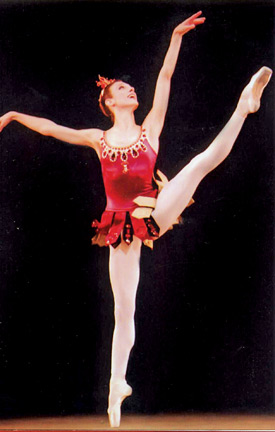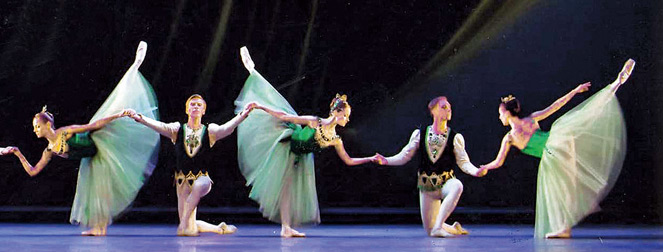Balanchine's sparkling emeralds
by Gwen Herat
There is no other person like George Balanchine who wrote ballet into
history, longer than anyone else. Every company around the world, East
or West, holds his works in their repertories and none of them gather
dust.
|

Part 1. from Jewels, Rubies danced by Sarah Lamb from the
Royal Ballet |
No ensemble has escaped his eyes, no dancer his choreography and no
composer his music. He never deviated from classicissm or from an
original plot but his great creative ideas at times, mixed classics and
contemporary mildly where it was necessary. For example, when he
choreographed Jewels in 1966, the audiences simply went crazy.
I saw Jewels a few years ago which was Balanchine's production. It
was boarded by Elyse Borne and Patriciia Nearly for the Royal Ballet in
its entirety for the first time. I remember the year to be 2007.
Jwels in three parts of Emeralds, Rubies and Diamonds were premiered
way back in 1967 at the New York City Ballet and in 2007 by the Royal
Ballet, the version I saw at Covent Garden.
The ballet was an instant hit mainly because of the spectacular
costumes where the dancers were dressed like the precious stones that
made up the three parts in Jewels. It was a triumphant debut for
Balanchine as well as for The Royal Ballet.
Praise
It drew high praise for the way the Company infused its work
retaining its own personality, while honouring the distinctly varied
styles choreographed in each part.
Though it was created for the New York City Ballet in 1967 in three
separate and complete abstract mini ballets, each linked with each other
in their glorious colour themes to gemstones and explore a choreographic
style as never seen before. Together, they reflected Balanchine's dance
influence on history.
Second nature to the company's dancers from a long relationship with
the production of Giselle is the Romantic Fresh manner of Emeralds.
It begins the sequence with music scored by Faure for Giselle as the
drifting sylphs and their cavaliers inhabiting a courtly and melancholy
dream-world.
That is the first part in the ballet. The second is Rubies that
depicts a startling contrast to introduce mid 20th-century jazz infected
aura by Stravinsky. In it a cheeky girl steps in and the swagger male
roles are infectious. Lastly the third chapter, Diamonds adopts the
grand finale of the imperial ballet style of St. Petersburg.
Selecting three movements of Tchaikovsky's Third Symphony, the main
duet for the principle couple, the dazzling white tutu'd ensembles and
the final exhilarating prossional polonaise make Diamonds an ethereal
and glittering homage to the high classicism of Petipa.
Costumes
The magnificent gem-crusted costumes adapted from the original
costumes designed by Barabara Karinska by Royala Ballet's Holly Hynes
were fabulous and vibrant.
|

Part 2. from Jewels, Emeralds danced by the artists of the
Royal Ballet. Choreographed by George Balanchine, the
striking green in their costumes like the emeralds are by
Barbara Karinska. |
Jean-Marc Puissant''s glorious stage designs that supported Art
Nouveau for Emeralds, Art Deco for Rubies and Tsarist splendour for
Diamonds, dazzled every eye in the audience was especially commissioned
by the Company for this production.
Jewels remain one of the most illustrious and glamorous additions to
the repertoire of the Royal Ballet and often tried out by different
choreographers,
The wizard behind Jewels, George Melitonovich Balanchivadze was born
in St. Petersburg in 1904 and died in New York in 1983. This
Russian-American dancer, choreographer and director entered Petrograd
Ballet School in 1914, just ten years old at the time. Graduated in 1921
and became a member of the GATOB together to study music, Balanchine
created in 1920 for The Evenings Young Ballet. From the beginning, he
ran into trouble with his traditionally minded superiors by
choreographing very unconvential ballets.
He left for Germany with his small company of Soviet State Dancers.
In 1924 he was auditioned for Diaghilav who immediately engaged him and
in short time, promoted him as Chief Choreographer of his Ballets Russes
in 1925.
From this time his relationship with Stravinsky made them
inseparables in ballet productions. After Diaghilev's death, Balachine
rose to brilliant heights as no other choreographer and still held in
high esteem in the dance world. Jewels is a dedication to his
magnificent memory as beautiful as the gems found in it. |

